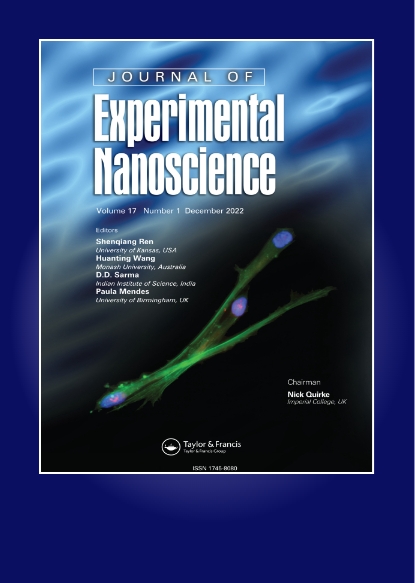Anti-breast carcinoma effects of green synthesized tin nanoparticles from Calendula officinalis leaf aqueous extract inhibits MCF7, Hs 319.T, and MCF10 cells proliferation
IF 2.6
4区 材料科学
Q2 CHEMISTRY, MULTIDISCIPLINARY
引用次数: 3
Abstract
Abstract In this study, tin nanoparticles were green synthesized using the aqueous extract of Calendula officinalis. Different techniques such as FE-SEM, XRD, FT-IR, and EDS analysis were used to characterize SnNPs@ C. officinalis. A 21.87 nm was obtained for the crystal size of the tin nanoparticles using XRD analysis. The FE-SEM images show a spherical morphology for SnNPs@ C. officinalis with a range size of 21.63–64.07 for the synthetic nanoparticles. The anti-breast cancer effects of biologically synthesized SnNPs@ C. officinalis against breast cancer cell lines were assessed. The anti-breast cancer properties of the SnNPs@ C. officinalis could significantly remove the MCF7, Hs 319.T, and MCF10 cancer cell lines in a time and concentration-dependent manner by MTT assay. The antioxidant activity of SnNPs@ C. officinalis was determined by the DPPH method. The SnNPs@ C. officinalis showed the highest antioxidant activity according to the IC50 value. It seems the anti-human breast cancer effect of recent nanoparticles is due to their antioxidant effects.金盏菊叶水提物绿色合成锡纳米颗粒抑制MCF7、Hs 319的抗乳腺癌作用T和MCF10细胞增殖
摘要本研究以金盏菊水提物为原料合成了绿色纳米锡。采用FE-SEM、XRD、FT-IR、EDS等技术对SnNPs@ C. officinalis进行表征。通过XRD分析得到了锡纳米粒子的晶粒尺寸为21.87 nm。FE-SEM图像显示SnNPs@ C. officinalis的形貌为球形,粒径范围为21.63 ~ 64.07。研究了生物合成SnNPs@ C. officinalis对乳腺癌细胞系的抗乳腺癌作用。SnNPs@ C. officinalis的抗乳腺癌特性可以显著去除MCF7, Hs 319。MTT法在时间和浓度依赖性上检测MCF10癌细胞。采用DPPH法测定SnNPs@ officinalis的抗氧化活性。根据IC50值,SnNPs@ C. officinalis的抗氧化活性最高。最近的纳米颗粒的抗乳腺癌作用似乎是由于它们的抗氧化作用。
本文章由计算机程序翻译,如有差异,请以英文原文为准。
求助全文
约1分钟内获得全文
求助全文
来源期刊

Journal of Experimental Nanoscience
工程技术-材料科学:综合
CiteScore
4.10
自引率
25.00%
发文量
39
审稿时长
6.5 months
期刊介绍:
Journal of Experimental Nanoscience, an international and multidisciplinary journal, provides a showcase for advances in the experimental sciences underlying nanotechnology and nanomaterials.
The journal exists to bring together the most significant papers making original contributions to nanoscience in a range of fields including biology and biochemistry, physics, chemistry, chemical, electrical and mechanical engineering, materials, pharmaceuticals and medicine. The aim is to provide a forum in which cross fertilization between application areas, methodologies, disciplines, as well as academic and industrial researchers can take place and new developments can be encouraged.
 求助内容:
求助内容: 应助结果提醒方式:
应助结果提醒方式:


